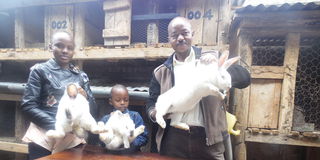The money in rabbit farming

Eric Njagi holds rabbits with his family at his Tharaka Nithi farm. The entrepreneur has 95 rabbits.
What you need to know:
- He began his venture with three rabbits, two does and one buck.
- The health, vigour, survival and reproduction rate of rabbits depends on how well you feed and care for them. A rabbit production enterprise will only be successful if you meet its dietary needs
When Eric Njagi bought three rabbits, two does and one buck, two years ago, they were solely to provide meat for his family.
But then he noticed that his simple set up was attracting lots of attention from friends and neighbours who wanted to know how to construct a hutch like his since they too wanted to rear rabbits.
When his does gave birth therefore, he had no shortage of buyers for the kits. With a rising demand for the kits, Njagi saw a business opportunity, and redesigned and increased the hutches to accommodate more rabbits, venturing into commercial rabbit farming.
Today, Njagi’s homestead in Kahawa Village in Tharaka Nithi County holds 24 hutches, which house over 95 rabbits.
“I had previously tried my luck in other farming projects, but the cost of production weighed me down,” says the 35-year-old former teacher, pointing out that production costs in rabbit farming are quite low compared to other types of farming.
Besides, rabbits are less demanding, require minimal space, less food, less labour and mature quite fast, offering a quick return on investment.
When we visited his farm, he had 15 mature rabbits and 70 kits. On average, he sells 20 kits a month. Mature rabbits retail at Sh3,000.
“The health, vigour, survival and reproduction rate of rabbits depends on how well you feed and care for them," he says.
"A rabbit production enterprise will only be successful if you meet its dietary needs,” explains the farmer, pointing out that feeding rabbits on forage and kitchen waste will hinder their growth rate and overall performance.
He further cautions that some kitchen waste such as potato peels may be poisonous.
Njagi feeds his solely on concentrates while minimally supplementing with hay, dairy meal, sow and weaner and specific dried forage. Rabbit meat, he points out, is not only very tasty, it is also nutritious and easily digestible, with a high ratio of protein, calcium and vitamin than any other type of animal meat.
Besides selling meat, he utilises the rabbit urine and droppings, which are rich in ammonia and nitrates.
“With the cost of fertiliser rising, I use rabbit manure rather than commercial fertilisers on my farm.”
He notes that tapping of urine is a marketing opportunity not fully exploited by many farmers due to poor construction of hatches.
“To maximise on the opportunity, farmers should construct modern self-cleaning hutches with a well installed urine collection system, as a litre of urine can range between Sh100 and Sh300,” he advises.
Rabbit skin is also useful, since it is used to make items such as shoes, belts and handbags – it is also used to make ornaments and fishing rods.
Different breeds, he says, are kept for different reasons, say meat, skin or urine, therefore it is important to do market research before investing in the business.
“For starters, one can begin with two rabbits with the only costs incurred being feed and the materials required to set up the cage, you can then expand as the rabbits breed – you need to host individual rabbits to avoid inbreeding, which lowers production,” he advises.
If interested in this kind of farming, select rabbits from recognised breeders with a reputation of selling high quality rabbits, but more important, those that suit your local weather conditions.
“Lay a good foundation and choose the market to satisfy to make your enterprise profitable – the demand is high and the supply is low, therefore there is good money to be made.”





